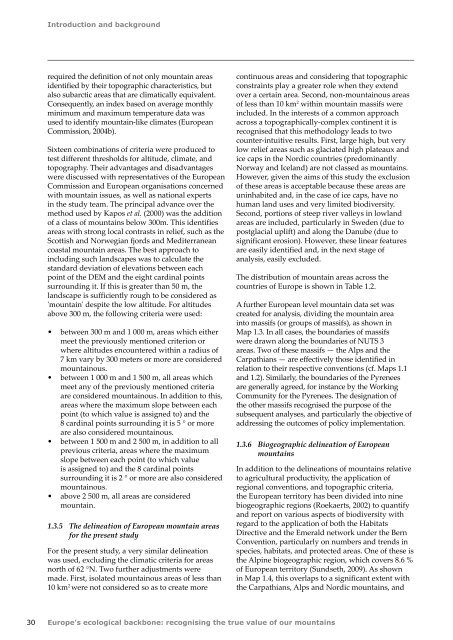Europes ecological backbone.pdf
Europes ecological backbone.pdf
Europes ecological backbone.pdf
You also want an ePaper? Increase the reach of your titles
YUMPU automatically turns print PDFs into web optimized ePapers that Google loves.
Introduction and background<br />
required the definition of not only mountain areas<br />
identified by their topographic characteristics, but<br />
also subarctic areas that are climatically equivalent.<br />
Consequently, an index based on average monthly<br />
minimum and maximum temperature data was<br />
used to identify mountain-like climates (European<br />
Commission, 2004b).<br />
Sixteen combinations of criteria were produced to<br />
test different thresholds for altitude, climate, and<br />
topography. Their advantages and disadvantages<br />
were discussed with representatives of the European<br />
Commission and European organisations concerned<br />
with mountain issues, as well as national experts<br />
in the study team. The principal advance over the<br />
method used by Kapos et al. (2000) was the addition<br />
of a class of mountains below 300m. This identifies<br />
areas with strong local contrasts in relief, such as the<br />
Scottish and Norwegian fjords and Mediterranean<br />
coastal mountain areas. The best approach to<br />
including such landscapes was to calculate the<br />
standard deviation of elevations between each<br />
point of the DEM and the eight cardinal points<br />
surrounding it. If this is greater than 50 m, the<br />
landscape is sufficiently rough to be considered as<br />
'mountain' despite the low altitude. For altitudes<br />
above 300 m, the following criteria were used:<br />
• between 300 m and 1 000 m, areas which either<br />
meet the previously mentioned criterion or<br />
where altitudes encountered within a radius of<br />
7 km vary by 300 meters or more are considered<br />
mountainous.<br />
• between 1 000 m and 1 500 m, all areas which<br />
meet any of the previously mentioned criteria<br />
are considered mountainous. In addition to this,<br />
areas where the maximum slope between each<br />
point (to which value is assigned to) and the<br />
8 cardinal points surrounding it is 5 ° or more<br />
are also considered mountainous.<br />
• between 1 500 m and 2 500 m, in addition to all<br />
previous criteria, areas where the maximum<br />
slope between each point (to which value<br />
is assigned to) and the 8 cardinal points<br />
surrounding it is 2 ° or more are also considered<br />
mountainous.<br />
• above 2 500 m, all areas are considered<br />
mountain.<br />
1.3.5 The delineation of European mountain areas<br />
for the present study<br />
For the present study, a very similar delineation<br />
was used, excluding the climatic criteria for areas<br />
north of 62 °N. Two further adjustments were<br />
made. First, isolated mountainous areas of less than<br />
10 km 2 were not considered so as to create more<br />
continuous areas and considering that topographic<br />
constraints play a greater role when they extend<br />
over a certain area. Second, non‐mountainous areas<br />
of less than 10 km 2 within mountain massifs were<br />
included. In the interests of a common approach<br />
across a topographically-complex continent it is<br />
recognised that this methodology leads to two<br />
counter-intuitive results. First, large high, but very<br />
low relief areas such as glaciated high plateaux and<br />
ice caps in the Nordic countries (predominantly<br />
Norway and Iceland) are not classed as mountains.<br />
However, given the aims of this study the exclusion<br />
of these areas is acceptable because these areas are<br />
uninhabited and, in the case of ice caps, have no<br />
human land uses and very limited biodiversity.<br />
Second, portions of steep river valleys in lowland<br />
areas are included, particularly in Sweden (due to<br />
postglacial uplift) and along the Danube (due to<br />
significant erosion). However, these linear features<br />
are easily identified and, in the next stage of<br />
analysis, easily excluded.<br />
The distribution of mountain areas across the<br />
countries of Europe is shown in Table 1.2.<br />
A further European level mountain data set was<br />
created for analysis, dividing the mountain area<br />
into massifs (or groups of massifs), as shown in<br />
Map 1.3. In all cases, the boundaries of massifs<br />
were drawn along the boundaries of NUTS 3<br />
areas. Two of these massifs — the Alps and the<br />
Carpathians — are effectively those identified in<br />
relation to their respective conventions (cf. Maps 1.1<br />
and 1.2). Similarly, the boundaries of the Pyrenees<br />
are generally agreed, for instance by the Working<br />
Community for the Pyrenees. The designation of<br />
the other massifs recognised the purpose of the<br />
subsequent analyses, and particularly the objective of<br />
addressing the outcomes of policy implementation.<br />
1.3.6 Biogeographic delineation of European<br />
mountains<br />
In addition to the delineations of mountains relative<br />
to agricultural productivity, the application of<br />
regional conventions, and topographic criteria,<br />
the European territory has been divided into nine<br />
biogeographic regions (Roekaerts, 2002) to quantify<br />
and report on various aspects of biodiversity with<br />
regard to the application of both the Habitats<br />
Directive and the Emerald network under the Bern<br />
Convention, particularly on numbers and trends in<br />
species, habitats, and protected areas. One of these is<br />
the Alpine biogeographic region, which covers 8.6 %<br />
of European territory (Sundseth, 2009). As shown<br />
in Map 1.4, this overlaps to a significant extent with<br />
the Carpathians, Alps and Nordic mountains, and<br />
30 Europe's <strong>ecological</strong> <strong>backbone</strong>: recognising the true value of our mountains

















